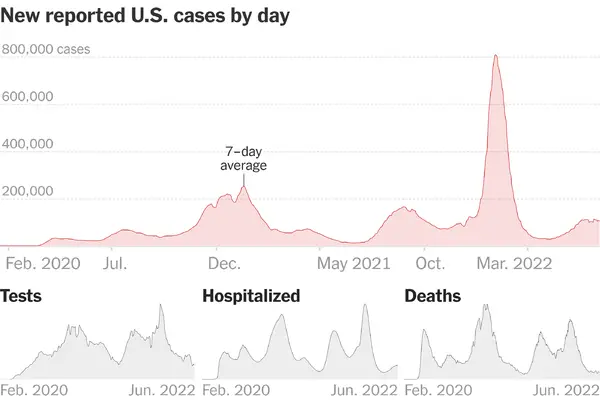

More and more office workers are being called back to their cubicles after two years of remote work. Many people don’t have it.
The revolt against return-to-office mandates was written about by my colleague Emma Goldberg. I talked to her recently to hear more.
How would you describe it?
The return-to-office conversations are almost like a game of chicken. Employers have lost their fear factor when they have delayed R.T.O. dates. Some workers are looking at these deadlines as abstract rather than as something hard and fast that will be enforced, which means that as companies have started to say, ‘No, we really do want to see you back in the office.’
How many people have come back?
Occupancy is still below 50 percent in major cities. When executives were asked about the share of workers who would return to work five days a week in the future, they said 50 percent. They are saying 20 percent now. There is a lot of optimism around return-to-office plans that is disappearing.
Why is this going on now?
Many companies had to delay their return-to-office days because of Covid surge last summer and fall. Companies are reacting to Covid’s spread by postponing return-to-office dates. The more return-to-office plans are delayed or suspended, the less rigid they seem to be.
There is a tight labor market and workers are feeling more confident. At Apple, some workers wrote an open letter to the company saying that they really didn’t want to go back to the office, and they used strong language like “Stop treating us like school kids” and “Stop trying to control how often you can see us.” Apple stopped requiring workers to return to the office at least three days a week.
One aspect of this is that the longer people work from home, the more attached they get to the habits they have formed, like not having to commute and being able to approach their schedules a little more flexibility.
What will the next phase look like?
We are entering a phase of adventure. Some employers who initially planned for more sweeping office reopenings are now embracing flexibility. About 10 percent of employees at Google have been given permission to go fully remote or relocate from the offices they were hired in. Managers and teams are able to set their own expectations at other companies.
We have seen companies that are sticking with hybrid rules, like three days in the office and two at home, or even five days in the office.
60 percent of workers who could do their jobs at home wanted to keep working from home most or all of the time, according to a survey from the Pew Research Center. There is a clash between executives, managers and some workers who really want to be back, and a lot of other people who are attached to flexibility that working from home allows. It is interesting. We may get more answers this summer or early fall.
There is more on work culture.
Readers were asked how R.T.O is going to help them. Everyone who wrote in is appreciated.
Being back in the office has been detested by me. My work is not team-based at all, and I spend all of my time in the office sitting in my cubicle with headphones on and staring at my computer screen. My organization’s real-estate investment into the office property is worth something to them, as I feel like a sack of flesh in an Aeron chair. Speak up when you are dissatisfied and be vocal about your concerns. Someone will eventually hear something. If you don’t know your worth, find something else.
I returned to work in February after having two babies in March 2020. I was adjusting to a life as a working mom that included getting called by day care to pick up a sick little one, as well as readjusting to my office life. I ripped off the Band-Aid and it came back well. Having child-free time, speaking with my colleagues, and putting on real clothes in the morning is what I enjoy the most. You might find that it is not as scary as you thought.
I work in the higher ed. Since students were coming back to classes, we should be there as well. Only a small number of students are around during the summer months. It feels arbitrary to force our presence. When you realize that tenure-track faculty have always had flexibility, it’s absurd. disproportionately people of color and women should have the same latitude as junior faculty.
It’s a nightmare. The lights don’t stay on because the motion sensors aren’t being triggered Julia Marcus, Boston said, “I will occasionally glimpse a human, alone in their office or conference room, door closed on zoom.”
Three days a week my employer requires staff to come into the office. I have had Covid, the flu and a bad cold in six weeks, and spread it to my family, including a toddler who hasn’t received all her vaccines yet. I was not an effective employee and took a lot of sick days. If you are on public transportation, double up. Try to go off peak times.
My return-to-office experience has been great, mostly due to the fact that I am able to more clearly see between work and life. Alex Stevens, New York City, said that he closes his laptop earlier, gets on the subway, and walks through the front door of his apartment.
My supervisor told me not to drink the water on my first day back to work. People are concerned about the quality of the water in the old office building because it has not been used in a long time. That is one of the things that makes it so frustrating to wake up early and commute through Atlanta traffic to an office that no one has needed for two years. What is the reason? If you want to adjust back to the routines of office life, my advice is to develop aMindfulness routine Investing in a gallon-size water bottle is a good idea.
-
The vaccine for children under 6 years old is being discussed at a C.D.C. advisory panel. Surprises are not expected.





